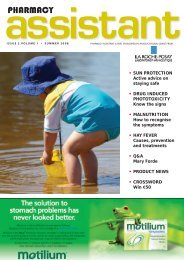veNTIlATIoN - Green Cross Publishing
veNTIlATIoN - Green Cross Publishing
veNTIlATIoN - Green Cross Publishing
Create successful ePaper yourself
Turn your PDF publications into a flip-book with our unique Google optimized e-Paper software.
clinical review<br />
14<br />
Non-invasive ventilation<br />
— an overview for the primary care nurse<br />
NoreeN doNoghue<br />
RGN, RM, ICU CERT, H DIP NURSING (RESP), MSC NURSING (HONS),<br />
RESPIRATORy CLINICAL NURSE SPECIALIST, UNIVERSITy HOSPITAL, GALWAy<br />
Community nurses are meeting increasing numbers of patients on non-invasive<br />
ventilation (NIV) in the home setting. This article aims to provide an overview of NIV<br />
which may assist them in providing effective care to this cohort of patients. An outline<br />
of the appropriate NIV equipment used in primary care, a troubleshooting guide of<br />
common problems encountered, and the provision of some useful contact resources<br />
are included.<br />
Introduction<br />
One of the most exciting developments in respiratory medicine<br />
in the last two decades has been the development of noninvasive<br />
ventilation (NIV) as a treatment modality for the<br />
management of respiratory failure. The field of non-invasive<br />
ventilation continues to expand rapidly in the management of<br />
acute and chronic respiratory conditions, both in the hospital<br />
and in domiciliary contexts. This advancement has major<br />
implications for nursing practice, management and education<br />
in both primary and secondary care. Many patients who<br />
previously required hospitalisation with respiratory failure, can<br />
now live at home using NIV with the support from the primary<br />
care team.<br />
NIv — definition<br />
Non-invasive ventilation (NIV) refers to ‘the provision of<br />
ventilatory support through the patient’s upper airway using a<br />
mask or similar device’. ¹<br />
This may be:<br />
• Continuous positive airways pressure (CPAP) — where the<br />
machine delivers a flow of air at a preset constant pressure<br />
during inspiration and expiration, or<br />
• Bi-level positive airways pressure (BiPAP) ventilation which<br />
works on the principle of pressure support, delivering gases<br />
at two levels of positive pressure — inspiratory positive<br />
airway pressure (IPAP) which produces ventilation, and<br />
expiratory positive airway pressure (EPAP) which increases<br />
functional residual capacity and recruits under-ventilated<br />
lungs, improving oxygenation.<br />
These treatments may be used as the sole treatment, a<br />
holding measure, a trial prior to intubation or the ceiling of<br />
treatment² with the aim to produce:<br />
• Decreased work of breathing<br />
• Increased tidal volume<br />
• Decreased respiratory rate<br />
glossary<br />
NIv: non-invasive ventilation (non-invasive positive<br />
pressure ventilation)<br />
cPAP: continuous positive pressure ventilation<br />
IPAP: inspiratory positive airway pressure<br />
ePAP: expiratory positive airway pressure<br />
osAhs: obstructive sleep apnoea/hypopnoea<br />
syndrome<br />
coPd: chronic obstructive airways disease<br />
‘It is important that<br />
nurses in primary care<br />
understand the nature<br />
and consequences<br />
of the patient’s<br />
respiratory condition,<br />
and the basic principles<br />
of how the ventilator<br />
works.’










